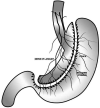Technical Tips Following 850 Consecutive One Anastomosis Gastric Bypass (OAGB) Patients
- PMID: 37663432
- PMCID: PMC10473180
- DOI: 10.4293/JSLS.2023.00024
Technical Tips Following 850 Consecutive One Anastomosis Gastric Bypass (OAGB) Patients
Abstract
Background: The surgical procedure One Anastomosis Gastric Bypass (OAGB) has become widely used worldwide. Since its inception, many modifications have been introduced to improve results.
Objectives: The primary aim of this study was to share the modifications that we have introduced to our OAGB technique after reflecting on the problems and complications we have faced during the evolution of this procedure in our unit.
Method: A total of 850 patients who underwent OAGB under the same surgical team at two different hospitals in the United Kingdom were displayed according to demography and comorbidities. All complications were reviewed and analysed to instigate the changes in our technique.
Results: There were 756 (89%) primary and 94 (11%) revisional procedures. There were 596 females (70.11%) and 254 males (29.89%) in our study group. The body mass index range was 32-84 and the mean was 45. The pre-operative weight range was 89-274 kg and the mean was 126.4 kg.
Conclusions: With experience and reflecting on our complications we have modified our surgical approach, and these alterations have helped us to adopt OAGB as the mainstream bariatric procedure. We want to share our experience with the bariatric community for the benefit of patient care.
Keywords: Bariatric surgery; Gastric bypass; Mini-gastric bypass; One anastomosis gastric bypass; Weight loss.
© 2023 by SLS, Society of Laparoscopic & Robotic Surgeons.
Conflict of interest statement
Conflict of interests: none.
Figures
Similar articles
-
Protein-Calorie Malnutrition Requiring Revisional Surgery after One-Anastomosis-Mini-Gastric Bypass (OAGB-MGB): Case Series from the Tehran Obesity Treatment Study (TOTS).Obes Surg. 2019 Jun;29(6):1714-1720. doi: 10.1007/s11695-019-03741-7. Obes Surg. 2019. PMID: 30706320
-
Changes in HOMA-IR index levels after bariatric surgery: Comparison of Single Anastomosis Duodenal Switch-proximal approach (SADS-p) and One Anastomosis Gastric Bypass-Mini Gastric Bypass (OAGB-MGB).Int J Surg. 2020 Jun;78:36-41. doi: 10.1016/j.ijsu.2020.04.008. Epub 2020 Apr 17. Int J Surg. 2020. PMID: 32305534
-
Conversion of one-anastomosis gastric bypass to Roux-en-Y gastric bypass: short-term results from a tertiary referral center.Surg Obes Relat Dis. 2019 Nov;15(11):1896-1902. doi: 10.1016/j.soard.2019.09.059. Epub 2019 Sep 11. Surg Obes Relat Dis. 2019. PMID: 31611182
-
One Anastomosis/Mini Gastric Bypass (OAGB-MGB) as revisional bariatric surgery after failed primary adjustable gastric band (LAGB) and sleeve gastrectomy (SG): A systematic review of 1075 patients.Int J Surg. 2020 Sep;81:32-38. doi: 10.1016/j.ijsu.2020.07.007. Epub 2020 Jul 29. Int J Surg. 2020. PMID: 32738545
-
Randomized Controlled Trial of One Anastomosis Gastric Bypass Versus Roux-En-Y Gastric Bypass for Obesity: Comparison of the YOMEGA and Taiwan Studies.Obes Surg. 2019 Sep;29(9):3047-3053. doi: 10.1007/s11695-019-04065-2. Obes Surg. 2019. PMID: 31290104 Review.
References
-
- Rutledge R. The mini-gastric bypass: experience with the first 1,274 cases. Obes Surg. 2001;11(3):276–280. - PubMed
-
- Carbajo M, García-Caballero M, Toledano M, Osorio D, García-Lanza C, Carmona JA. One-anastomosis gastric bypass by laparoscopy: results of the first 209 patients. Obes Surg. 2005;15(3):398–404. - PubMed
-
- Johnson WH, Fernanadez AZ, Farrell TM, et al. . Surgical revision of loop (“mini”) gastric bypass procedure: multicenter review of complications and conversions to Roux-en-Y gastric bypass. Surg Obes Relat Dis. 2007;3(1):37–41. - PubMed
MeSH terms
LinkOut - more resources
Full Text Sources
Medical

